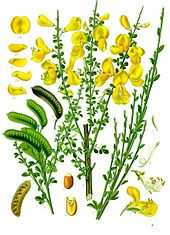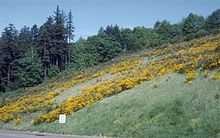Cytisus scoparius
| Cytisus scoparius | |
|---|---|
| | |
| Scientific classification | |
| Kingdom: | Plantae |
| (unranked): | Angiosperms |
| (unranked): | Eudicots |
| (unranked): | Rosids |
| Order: | Fabales |
| Family: | Fabaceae |
| Genus: | Cytisus |
| Species: | C. scoparius |
| Binomial name | |
| Cytisus scoparius (L.) Link | |
| Synonyms[1] | |
|
List
| |
Cytisus scoparius, the common broom or Scotch broom, syn. Sarothamnus scoparius, is a perennial leguminous shrub native to western and central Europe.[2] In Britain and Ireland, the standard name is broom,[3][4][5] but this name is also used generically for other related species (see broom), and the term common broom is sometimes used for clarification.[6][7] In other English-speaking countries, the most prevalent common name is Scotch broom[8] (or Scot's broom); English broom is also occasionally used.
Classification
There are two subspecies of Cytisus scoparius:[2][3]
- Cytisus scoparius subsp. scoparius. Throughout the species' range.
- Cytisus scoparius subsp. maritimus (Rouy) Heywood. Western Europe, on maritime cliffs. Differs in prostrate growth, not over 0.4 m tall, and downy young shoots.
Description

Plants of Cytisus scoparius typically grow to 1–3 m (3–9 ft) tall, rarely to 4 m (13 ft), with main stems up to 5 cm (2 in)thick, rarely 10 cm (4 in). The shrubs have green shoots with small deciduous trifoliate leaves 5–15 mm long, and in spring and summer is covered in profuse golden yellow flowers 20–30 mm from top to bottom and 15–20 mm wide. Flowering occurs after 50-80 growing degree days. In late summer, its legumes (seed pods) mature black, 2–3 cm long, 8 mm broad and 2–3 mm thick; they burst open, often with an audible crack, forcibly throwing seed from the parent plant. This is the hardiest species of broom, tolerating temperatures down to about −25 °C (−13 °F).[3][5][9] C. scoparius contains toxic alkaloids that depress the heart and nervous system.[10]
Distribution and habitat
Cytisus scoparius is found in sunny sites, usually on dry, sandy soils at low altitudes.[3] In some places outside of its native range, such as India, South America and western North America, it has become an ecologically destructive colonizing invasive species in grassland, shrub and woodland, and other habitats.[11][12]
As a legume, this shrub can fix nitrogen in the soil through a symbiotic relationship with Rhizobium bacteria.
Cultivation
Cytisus scoparius is widely cultivated as an ornamental plant, with several cultivars selected for variation in flower colour, including "Moonlight" with deep yellow flowers, "Andreanus" and "Firefly" with dark orange-red flowers, and growth habit, including "Pendula" with pendulous branchlets.[9]
Invasive species

C. scoparius has been introduced into several other continents outside its native range and is classified as a noxious invasive species in California and the Pacific Northwest in North America,[11] and in Australia,[13] New Zealand[14] and India.[15] These shrubs commonly grow in disturbed areas and along utility and transportation rights-of-way. The prolific growth of this species after timber harvest inhibits reforestation by competing with seedling trees.[16] It is estimated that it is responsible for US$47 million in lost timber production each year in Oregon.[17] In New Zealand, broom is estimated to cost the forestry industry NZ$90 million, and to cost farmers NZ$10 million.[18]
Biological control for broom has been investigated since the mid-1980s with a number of species being trialled. They include the broom twig miner (Leucoptera spartifoliella), the broom seed beetle (Bruchidius villosus), the broom gall mite (Aceria genistae), the sap-sucking broom psyllid (Arytainilla spartiophila) and recently the broom leaf beetle (Gonioctena olivacea) and the broom shoot moth (Agonopterix assimilella).[19][20]
Phytochemicals
The characteristic constituents are biogenic amines (mostly tyramine in the young shoots), flavonoids (spiraeoside and scoparoside), isoflavones and their glycosides (genistin), as well as allelopathic quinolizidine alkaloids (mostly sparteine, lupanine, scoparin and hydroxy-derivatives), which defend the plant against insect infestation and herbivory (with the exception of the resistant Aphis cytisorum).[21][22]
Royal symbols
The name of the House of Plantagenet, rulers of England in the Middle Ages, was derived from common broom, which was then known as "planta genista" in Latin. The plant was used as a heraldic badge by Geoffrey of Anjou and five other Plantagenet kings of England as a royal emblem. The "broomscod", or seed-pod, was the personal emblem of Charles VI of France.
References
- ↑ "The Plant List: A Working List of All Plant Species". Retrieved April 3, 2014.
- ↑ 2.0 2.1 Flora Europaea: Cytisus scoparius
- ↑ 3.0 3.1 3.2 3.3 M. Blamey & C. Grey-Wilson (1989). Flora of Britain and Northern Europe. Hodder & Stoughton. ISBN 0-340-40170-2.
- ↑ Botanical Society of Britain and Ireland (zip file)
- ↑ 5.0 5.1 H. Vedel & J. Lange (1960). Trees and Bushes. London: Metheun.
- ↑ Wild Flowers of the Loch Lomond and Trossachs National Park, Scotland
- ↑ Garden World: common broom
- ↑ National Park Service: Scotch Broom
- ↑ 9.0 9.1 W. J. Bean (1970). Trees and Shrubs Hardy in the British Isles. London: John Murray. ISBN 0-7195-1790-7.
- ↑ Jim Pojar, A. MacKinnon & Paul B. Alaback (1994). Plants of the Pacific Northwest Coast: Washington, Oregon, British Columbia & Alaska. Redmond, WA: Lone Pine.
- ↑ 11.0 11.1 "Species Profile - Scotch Broom (Cytisus scoparius (L.))". National Invasive Species Information Center, United States National Agricultural Library. Archived from the original on July 26, 2013. Retrieved October 9, 2013.
- ↑ Ashfaq Ahmed Zarri, Asad R. Rahmani & Mark J. Behan (2006). "Habitat modifications by Scotch broom Cytisus scoparius invasion of grasslands of the Upper Nilgiris in India". Journal of the Bombay Natural History Society 103 (2–3): 356–365.
- ↑ Andrew W. Sheppard, Peter Hodge, Quentin Paynter & Mark Rees (2002). "Factors affecting invasion and persistence of broom Cytisus scoparius in Australia". Journal of Applied Ecology 39 (5): 721–734. doi:10.1046/j.1365-2664.2002.00750.x. JSTOR 827200.
- ↑ "Broom - outside Howard - St Arnaud". Pest Management. Nelson City Council. Retrieved 8 February 2012.
- ↑ K. J. B. Potter, D. J. Kriticos, M. S. Wait & A. Leriche (2009). "The current and future potential distribution of Cytisus scoparius: a weed of pastoral systems, natural ecosystems and plantation forestry". Weed Research 49 (3): 271–282. doi:10.1111/j.1365-3180.2009.00697.x.
- ↑ "Invasive Plant Species Management Plan: Appendix 7" (PDF). McDonald-Dunn Forest Plan. Oregon State University, College of Forestry. p. 10. Retrieved 2006-12-20.
- ↑ "Scotch broom". ODA Plant Division, Noxious Weed Control. Retrieved 2006-09-03.
- ↑ Press release (2008-02-12). "New bio-controls for pest plant". Landcare Research. Retrieved 2008-03-02.
- ↑ "What's New In Biological Control of Weeds?" (PDF). Landcare Research. November 2006. Retrieved 2008-03-02.
- ↑ CSIRO: Biological control
- ↑ Isamu Murakoshi, Yoshiaki Yamashita, Shigeru Ohmiya & Hirotaka Otomasu (1986). "(−)-3β-13α-dihydroxylupanine from Cytisus scoparius". Phytochemistry 25 (2): 521–524. doi:10.1016/S0031-9422(00)85514-4.
- ↑ Michael Wink, Thomas Hartmann, Ludger Witte & Joachim Rheinheimer (1982). "Interrelationship between quinolizidine alkaloid producing legumes and infesting insects: exploitation of the alkaloid-containing phloem sap of Cytisus scoparius by the broom aphid Aphis cytisorum" (PDF). Zeitschrift für Naturforschung 37: 1081–1086.
External links
| Wikimedia Commons has media related to Cytisus scoparius. |
| Wikispecies has information related to: Cytisus scoparius |